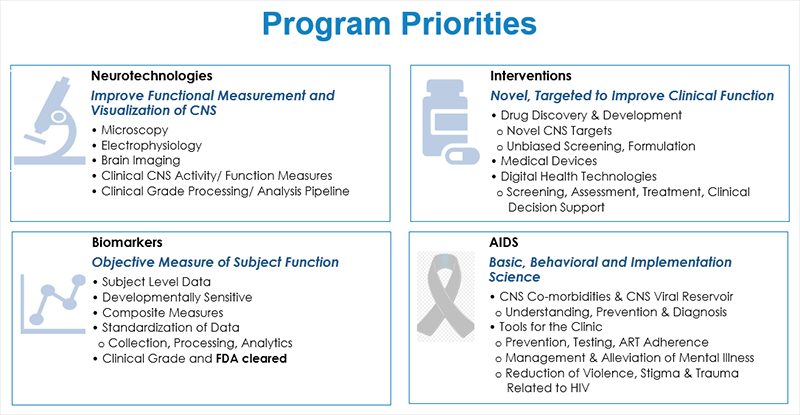NIMH SBIR/STTR Program Priorities
Program Priorities
The NIMH SBIR and STTR programs support research and development by small businesses that is aligned with the NIMH Strategic Plan and aimed at the development and validation of new methods, tools and technologies to advance understanding, prevention and treatment of mental illness and to understand normal brain function.
To be eligible for the SBIR/STTR Program research and development projects must have the potential to succeed commercially or to provide significant societal benefits in the areas of neuroscience and/or mental health.
The following resources serve as a guide for potential applicants and do not represent an exhaustive list of supported technologies. Please contact program staff to discuss potential applications prior to submission.

NIMH lists priority SBIR/STTR topics in NIMH SBIR/STTR FOAs and in the SBIR/STTR Program Descriptions and Research Topics Document .
Research Priorities
Research Priorities Supported by SBIR and STTR Technology Development
- NIMH Strategic Plan
Presents key scientific priorities and describes the need for tools to realize these priorities. - From Discovery to Cure
The National Advisory Mental Health Council’s Workgroup report elucidates principles and recommendations for the development of new and better interventions for individuals with mental illnesses. - Trans-NIH Strategic Plan for HIV-Related Research NIMH research priorities address issues concerning HIV/AIDS prevention, treatment, and care.
- Opportunities and Challenges of Psychiatric Genetics
Report of the National Advisory Mental Health Council Workgroup on Genomics. - NIMH Director's Messages
Gap Areas
Division of Neuroscience and Basic Behavioral Science (DNBBS)
- BRAIN Initiative -related technologies and quality improvements of BRAIN-related technological inventions.
- Improved Microscopy Imaging
- Ability to enhance single cell resolution while maintaining spatial and depth resolution, in vivo and ex vivo, automation of processes.
- Improved Measures of Brain Activity
- Multielectrode, range of depths, correlation with imaging/behavior, ability to streamline analysis, record for long periods of time, collect during social interactions, decreasing size, improving S/N, less injury.
- Novel preclinical and clinical imaging technologies with the potential to enhance our understanding of complex circuit function or neuropathology, with a long-term goal to measure or predict mental health outcomes.
- Examples: Optical imaging of neuroimmune interactions, imaging extracellular vesicles, metabolic tissue imaging and photoacoustic imaging.
- Clinical Electrophysiology
- Dry electrodes, easy application, clinical grade processing/analysis pipelines, combination image-related technology products, determination of minimal electrode ability to reflect brain activity vs. multi-electrodes and sufficiency for clinical studies/trials.
- MRI (including fMRI)
- Technical approaches to standardization, improved temporal/spatial resolution (including pediatric resolution), correlation with EEG/other activity measures.
- Software platforms to enable streamlined imaging and electrophysiology processing and analysis.
- Improved Microscopy Imaging
- Unbiased compound screening assays - in vitro/in vivo, to assess CNS effects.
- Drug discovery/development focused on novel CNS drug targets and novel compounds.
Division of Services and Intervention Research (DSIR)
- Training solutions that enhance provider screening skills for mental health disorders including suicide.
- Research to address challenges associated with the uptake and adherence/sustained use of technology-based approaches, practice related issues, subject attrition, limits of usage.
- Development and testing of natural language processing (NLP), machine learning algorithms and other artificial intelligence programs to enhance assessment, facilliate the delivery of personalized interventions and improve the potency of established interventions.
Division of Translational Research (DTR)
- BRAIN Initiative -related technologies and quality improvements of BRAIN-related technological inventions.
- Novel CNS activity/function measures for use in humans that are of high spatial/temporal resolution, high throughput, non-invasive.
- Devices capable of closed loop stimulation-response feedback.
- Novel clinical imaging technologies with the potential to enhance our understanding of complex circuit function or neuropathology, with a long-term goal to measure or predict mental health outcomes.
- Accurate early screening in pediatric populations.
- Objective measures (imaging, physiological, sensor-based, etc.) for use in stratification, pharmacodynamic response, outcomes, tolerance, safety to be incorporated into clinical trials for subjects with psychiatric symptoms.
- Novel brain stimulation methods/devices for targeted CNS stimulation, treatment of symptoms, clinical function in psychiatric populations
- Early stage clinical trials to test novel pharmacologic agents using pharmacokinetic/pharmacodynamic designs to optimize dosing for future efficacy trials.
- Digital health technologies that incorporate passive sensing, active assessments to objectively evaluate subject symptoms, trajectory, treatment response.
Division of AIDS Research
- Novel diagnostic approaches and therapeutic strategies to assess and treat HIV associated CNS disease in ART suppressed individuals.
- Molecular neuroimaging approaches to identify viral reservoirs in the CNS and tools to eradicate persistent viral reservoirs from the CNS.
- Novel tools and approaches to identify populations most vulnerable to HIV.
- Tools to facilitate dissemination and implementation of evidence-based HIV/AIDS behavioral risk reduction and adherence interventions.
- Novel tools to rapidly link individuals diagnosed with HIV to care, improve adherence and sustain patient retention.
- Development of point of care tests for viral load and drug adherence.
Research Requirements
- NOT-MH-19-053
Notice of NIMH’s Considerations Regarding the Use of Animal Neurobehavioral Approaches in Basic and Pre-clinical Studies - NOT-MH-18-058
Notice of NIMH’s interest in areas of Stress Biology Research. - Priorities in stress research: a view from the U.S. National Institute of Mental Health
- Support for Clinical Trials at NIMH
NIMH requires all clinical trials to use an experimental therapeutics approach , in which the studies do not only evaluate the clinical effect of the intervention, but also generate information about the mechanisms underlying a disorder or an intervention response.

